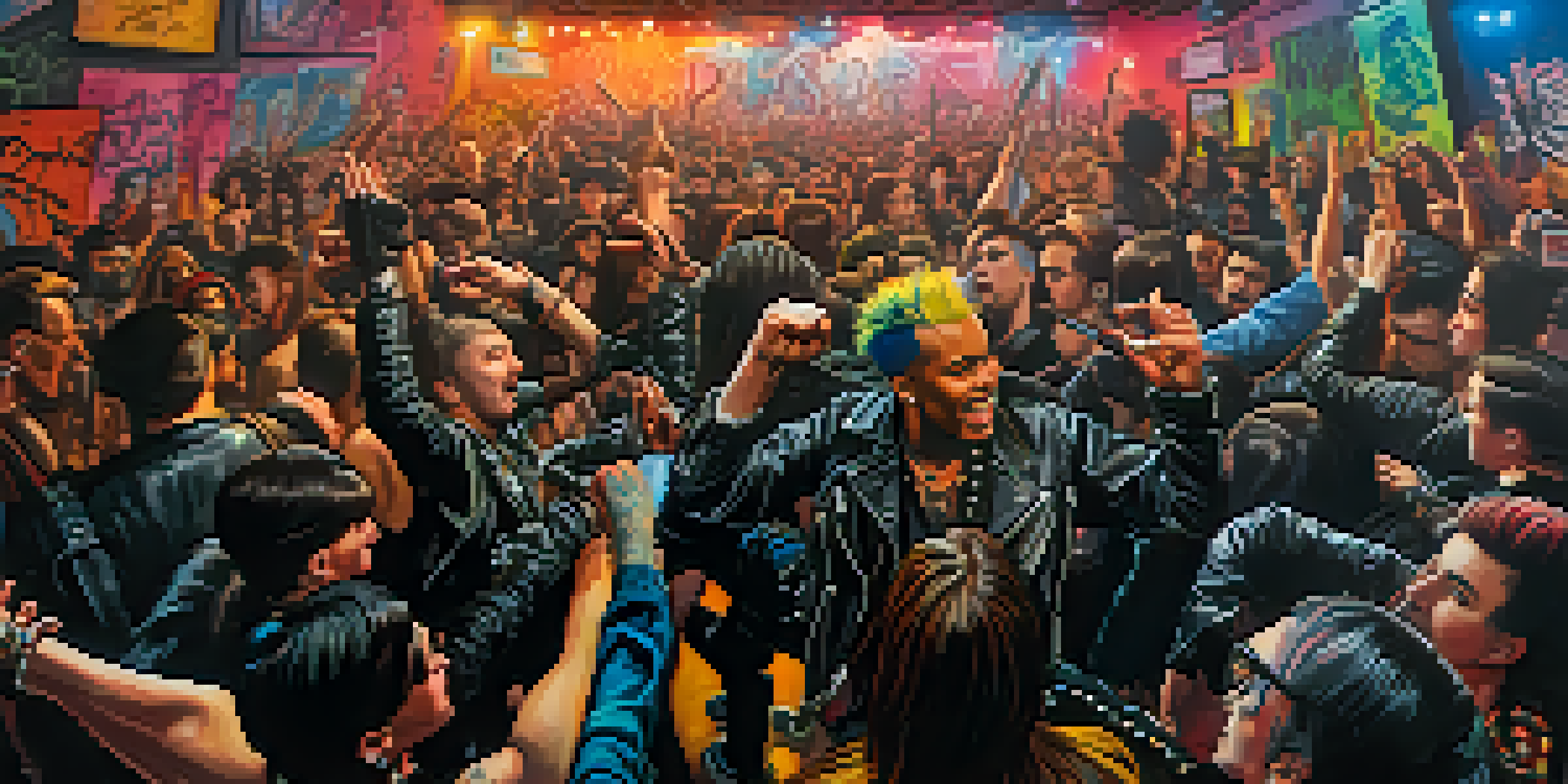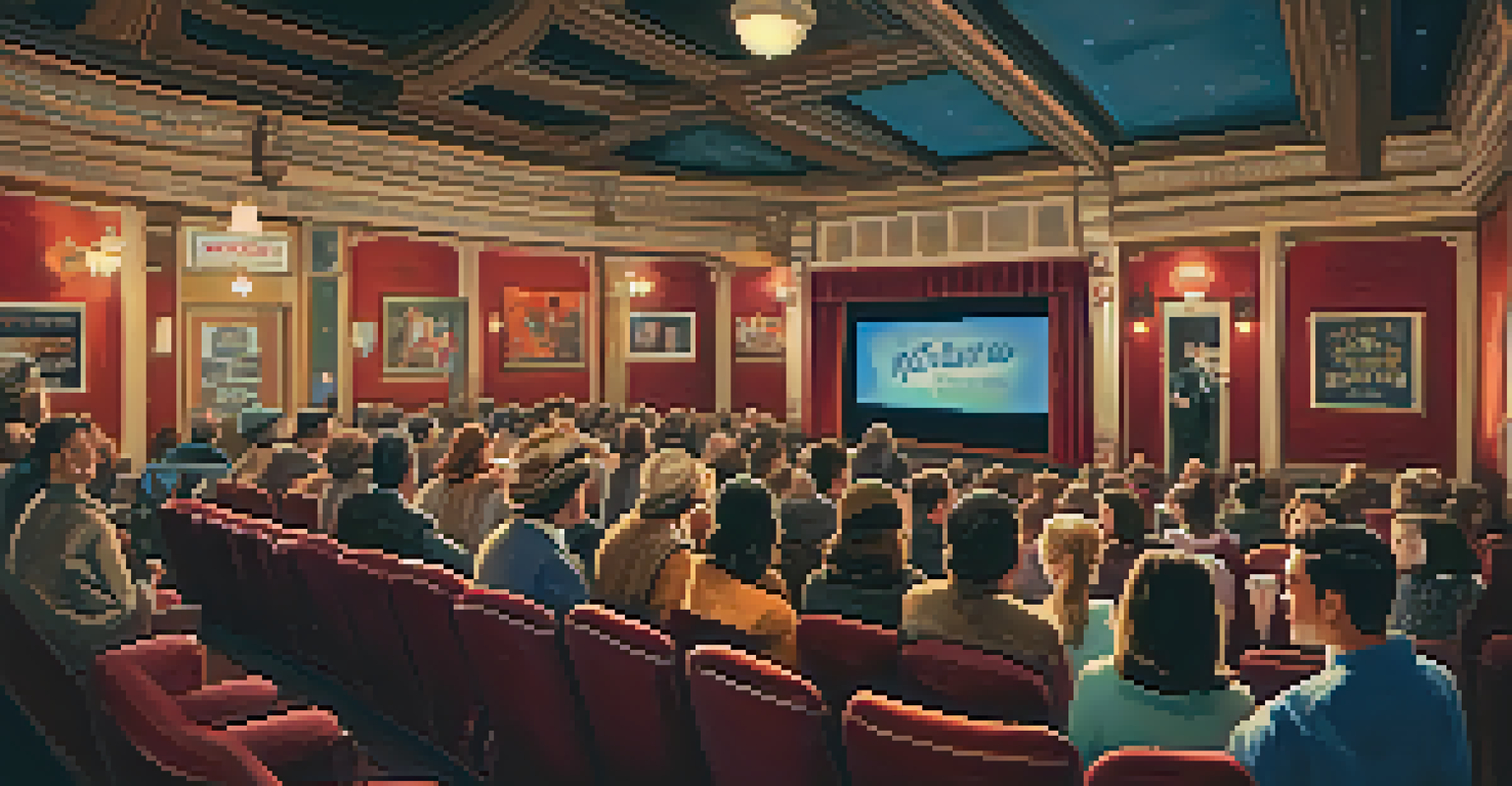Subcultures and Cult Films: A Deep Dive into Aficionados

Understanding Subcultures: More Than Just Groups
Subcultures are fascinating social phenomena that reflect unique identities, beliefs, and interests outside mainstream culture. Think of them as smaller communities that share specific passions, from music genres to fashion styles. For instance, the punk subculture emerged in the 1970s, characterized by its rebellious attitude and distinct fashion choices, like leather jackets and mohawks.
Subcultures are the heart of creativity and innovation, providing a platform for unique expressions of identity.
These groups often create their own norms and values, allowing members to express themselves freely. This sense of belonging is crucial for many, as it provides an escape from societal pressures. Consider how the goth subculture embraces darker aesthetics and themes, creating a supportive environment for individuals who feel out of place in conventional settings.
Ultimately, subcultures thrive on the passion of their members, fueling creativity and innovation. They often intersect with various art forms, including film, which leads us to explore the exciting world of cult films that resonate deeply with these communities.
Cult Films: The Heartbeat of Subcultures
Cult films are those beloved movies that attract a dedicated following, often due to their unconventional narratives, unique style, or countercultural messages. Think of films like 'The Rocky Horror Picture Show' or 'Fight Club,' which have transcended traditional cinematic boundaries to become cultural touchstones. These films often invite viewers to engage in a shared experience, creating a sense of community.

What makes a film cult-worthy can vary widely, but it often includes elements of absurdity, offbeat humor, or a strong subversive message. For example, 'Donnie Darko' gained a massive following for its complex themes and surreal storytelling, captivating audiences who found solace in its ambiguity. This connection to the film fosters a rich dialogue among fans, who dissect and discuss every frame.
Subcultures Shape Unique Identities
Subcultures provide communities where individuals can express their unique identities and beliefs outside mainstream culture.
Cult films also serve as a reflection of the subcultures that embrace them, embodying their values and ideologies. The shared experience of watching and discussing these films strengthens the bonds within subcultures, making the cinematic art form a powerful tool for expression and identity.
The Role of Fandom in Cult Film Subcultures
Fandom plays a pivotal role in the life of cult films, as it transforms casual viewers into passionate advocates. These fans often go above and beyond, creating fan art, organizing screenings, and even dressing up as characters from their favorite films. Think of the annual 'Rocky Horror' midnight screenings where audiences don costumes and participate in call-and-response antics—a testament to the film's lasting impact.
Cult films allow us to see ourselves and our struggles reflected back, creating a powerful sense of community and belonging.
Moreover, fandom fosters a sense of belonging among like-minded individuals who share the same passion. These communities can be found online in forums or social media platforms, where members discuss theories, share memorabilia, and plan events related to their favorite films. Such interactions enrich the experience, turning solitary movie-watching into a communal celebration.
Ultimately, fandom is more than just admiration for a film; it’s about creating a culture that celebrates all things related to that film. The passion of fans often leads to the revival of lesser-known movies, ensuring their place in cinematic history and introducing them to new generations.
Iconic Cult Films and Their Subcultural Impact
Several cult films have left an indelible mark on their respective subcultures, shaping identities and social movements. For instance, 'The Breakfast Club' resonated with teenagers in the 1980s, encapsulating the struggles of high school life and the search for identity. Its exploration of social cliques and personal growth struck a chord, influencing youth culture for decades.
Another example is 'Pulp Fiction,' which not only revolutionized storytelling in cinema but also became a defining film for Gen X. Its unique narrative structure and memorable dialogues created a new language among fans, cementing its place in pop culture. This film showcases how cult films can transcend their medium, influencing fashion, music, and even attitudes.
Cult Films Foster Community Bonds
Cult films create a shared experience among fans, strengthening connections and fostering a sense of belonging within subcultures.
These iconic films often serve as anthems for their subcultures, offering a sense of validation and representation. By addressing themes that resonate with audiences, they create a cultural dialogue that continues to evolve, making them vital pieces of cinematic history.
The Evolution of Cult Film Communities
Cult film communities have evolved significantly over the years, especially with the advent of the internet. What once required finding a local theater showing a midnight screening can now be done from the comfort of home, thanks to streaming services and social media. This shift has allowed fans to connect globally, sharing their love for niche films across borders.
Online platforms have also enabled the creation of dedicated fan sites, podcasts, and YouTube channels focused on cult films. These resources provide deeper insights, trivia, and discussions, enriching the viewing experience and fostering a sense of camaraderie among fans. It’s remarkable how a simple film can unite people from different walks of life around a shared passion.
Yet, while technology has expanded the reach of cult films, the essence of local screenings and in-person gatherings remains cherished. Events like film festivals and themed parties continue to celebrate these films, reinforcing community bonds and keeping the spirit of cult cinema alive.
The Intersection of Cult Films and Other Art Forms
Cult films often intersect with other art forms, creating a rich tapestry of cultural expression. For example, many cult films have inspired graphic novels, music, and even fashion trends. The visual storytelling found in films like 'Blade Runner' has influenced everything from cyberpunk fashion to electronic music, showcasing the power of cinematic art.
Moreover, the dialogue between cult films and other art forms can lead to innovative projects that push creative boundaries. Artists and musicians frequently draw inspiration from cult cinema, incorporating its themes and aesthetics into their work. This cross-pollination enriches both the film and the art world, highlighting the interconnectedness of cultural expression.
Evolving Fan Engagement with Films
With the rise of technology, cult film communities are expanding globally, allowing fans to connect and share their passions like never before.
Ultimately, this intersection enhances the overall experience for fans, encouraging them to explore different mediums inspired by their favorite films. As these connections grow, they further cement the importance of cult films within the broader cultural landscape.
The Future of Cult Films and Their Aficionados
The future of cult films and their communities looks promising as new generations of fans emerge. With the rise of streaming platforms, more obscure films are becoming accessible, allowing younger audiences to discover hidden gems. This shift could lead to the formation of new subcultures, as diverse tastes and interests continue to evolve.
Moreover, the increasing popularity of retro and vintage aesthetics in mainstream media opens the door for classic cult films to regain traction. Movies that once flew under the radar may find new life, inspiring a fresh wave of fandom and appreciation. The cyclical nature of pop culture ensures that these films remain relevant and influential.

As technology continues to advance, the ways in which fans engage with cult films will also evolve. Virtual reality screenings, interactive experiences, and immersive storytelling could redefine how audiences connect with their favorite films, ensuring that the passion for cult cinema endures for years to come.